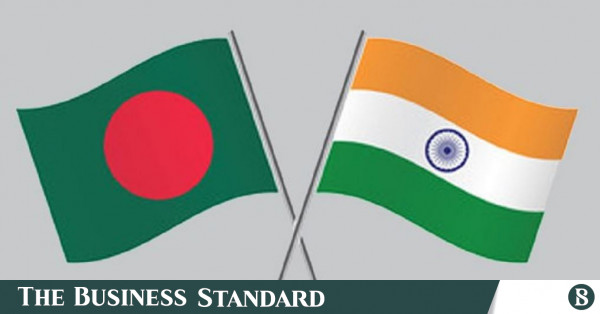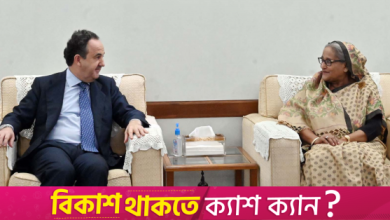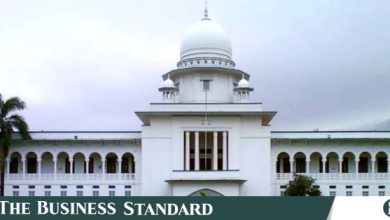India ‘over-invested in Hasina and under-invested in Bangladesh’: French media house


When Agontuk (pseudonym), a 21-year-old architecture student in Dhaka, first saw social media posts about attacks against Bangladesh’s Hindu minority, his immediate reaction was to check on a building in his neighborhood in the Bangladeshi capital that housed mostly Hindu residents.
Agontuk had been part of the student movement that ousted Sheikh Hasina, Bangladesh’s longest-serving prime minister. However, after a brutal crackdown that killed over 300 people, he avoided street protests. Instead, he joined a team of student volunteers using their tech skills to bypass online surveillance and overcome internet blackouts to draw international media attention to their cause, reports Franch 24.
Targeting Bangladeshi Hindus was never the intention of the student movement, noted Agontuk. The allegations of “pogroms” – with some even claiming a “genocide” – against the minority community were alarming.
“I was surprised because in our country, we live in harmony. We don’t want any chaos or anarchy between us. As soon as we heard the reports, we tried to figure out if they were authentic or not,” said the architecture student in a phone interview from the Bangladeshi capital.
Hours after Hasina’s ouster on August 5, when Agontuk checked in on the Hindu residential building in Dhaka’s Nobinbag neighborhood, everything was thankfully quiet. “There had not been a single attack in the area,” he recounted. “Over the next few days, I monitored that place, spoke to residents and shopkeepers in the area, and everything was okay.”
As reports of attacks on Hindu temples and businesses circulated, primarily on social media and Indian TV channels, Agontuk kept in touch with his friends and contacts across the city and country. “I communicate with them every day. They have also been monitoring the temples in their areas and have told me there have been no violations,” he said.
Shortly after Hasina fled to India, celebrations turned into mob violence as rioters targeted members of her Awami League party and symbols of her family’s political legacy, including statues and a museum dedicated to Hasina’s father, Sheikh Mujibur Rahman.
Hindus, the largest religious minority in Muslim-majority Bangladesh, make up about 8% of the country’s nearly 170 million population. They have traditionally supported the Awami League, putting them in the crosshairs of rioters.
In the week following Hasina’s ouster, there have been at least 200 attacks against Hindus and other religious minorities across the country, according to the Bangladesh Hindu Buddhist Christian Unity Council, a minority rights group.
But the exact figures and motivations for the violence have been difficult to determine. The police, hated by the students for leading the crackdown on protesters, had also suffered casualties and went on a weeklong strike after Hasina fled, reports the french media house.
In the chaotic days that followed, rumors and online misinformation heightened minority fears. Social media added to the confusion, especially after fact-checkers found several posts circulating old images and unsubstantiated claims, with much of the fake news traced to bots and trolls from neighboring India.
Religion – an old fault line on the Indian subcontinent and the cause of the bloody partition of colonial British India into modern South Asian nations – had resurfaced again.
But between the very real fears of Bangladeshi Hindus and the flood of misinformation coming from Hindu-majority India lies a diplomatic struggle for power, influence, resources, and access.
The fall of Hasina has highlighted a ruthless geopolitical game in South Asia that the international community was content to overlook but must now address, as the Bangladeshi uprising, dubbed the “Gen Z revolution,” has shuffled the diplomatic deck.
Monsoon revolution for all
The seriousness of the social unrest was immediately understood by Muhammad Yunus, a Nobel Laureate who accepted the post of chief adviser in a transitional government until elections are held.
Shortly after arriving in Dhaka from Paris, where he was attending the Olympic Games, Yunus told reporters that restoring order was his top priority.
On Monday, Yunus met with Hindu community members at the Dhakeshwari National Temple, the country’s largest Hindu shrine, where he called for patience and support in his government’s efforts to ensure equal rights and protections for all Bangladeshi citizens.
Many Bangladeshi students and civil society members have been doing their part to maintain order and protect minority rights. Social media sites, such as Instagram, are filled with photographs of students protecting temples across Bangladesh.
Shafqat Munir, senior fellow at the Dhaka-based Bangladesh Institute of Peace and Security Studies, believes inclusivity and plurality are important principles as Bangladesh navigates a post-Hasina era.
“First of all, we have had some unfortunate attacks on minority groups and people, but I must point out that there is an awful lot of disinformation out there,” he noted. “I want to say that for Bangladesh, for the people of Bangladesh, even one incident is too many. This revolution, which I call the Monsoon Revolution, is a revolution for all Bangladeshis, regardless of whatever faiths they follow. So it is absolutely critical for us to ensure that no particular group or individual is targeted for his or her faith. That’s very important.”
Hasina vs a ‘destablisied, Islamist Bangladesh’
But across Bangladesh’s 4,000-kilometre border with India, many news anchors, editors, and commentators are not convinced by the reassurances.
Mainstream Indian news outlets, which often serve as mouthpieces for Prime Minister Narendra Modi’s Hindu nationalist government, have focused on a Bangladeshi Islamist party. “What is Jamaat-e-Islami? The Pakistan-backed political party that brought down Sheikh Hasina’s government,” read one headline. “Jamaat may take control in Bangladesh,” read another, quoting a senior member of Modi’s Bharatiya Janata Party (BJP).
The Jamaat-e-Islami has never won a parliamentary majority in Bangladesh’s 53-year history, but it has periodically allied with the opposition Bangladesh Nationalist Party (BNP). Jamaat, as the party is widely known, was banned on August 1, when Hasina blamed the two opposition parties for the deaths during the anti-quota protests.
The BNP and Jamaat deny responsibility for the deadly violence in the lead-up to Hasina’s ouster. On Tuesday, a Bangladeshi court opened a murder investigation into Hasina and six members of her administration over the killing of a man during the civil unrest.
Bangladeshi student leaders have repeatedly told reporters that they were seeking fundamental change. Many expressed distrust of the country’s mainstream political parties, including the Awami League, BNP, and Jamaat.
Their decision to ask Yunus, a respected economist, to lead an interim administration reflected their desire for a break from a political past dominated by either the Awami League or the BNP.
But their message has failed to reassure Indian commentators. “I think that many Indians have bought into the narrative that Hasina and the Awami League had long put out, that Hasina was really the only thing standing between a secular, moderate Bangladesh and a Bangladesh destabilized by Islamist forces,” explained Michael Kugelman, director of the South Asia Institute at the Washington DC-based Wilson Center.
All eggs in the Hasina basket
Hasina’s domestic fall from grace was years in the making. While protests against a controversial government quota system provided the catalyst for her exit, public discontent had been growing since Bangladesh’s “Iron Lady” won her fourth consecutive term in the January 7 elections.
The US State department characterized the parliamentary elections as “not free or fair.” But regional rivals India and China rushed to congratulate the 76-year-old incumbent yet again.
The Indian prime minister’s praise for Hasina’s victory was particularly effusive. Ignoring the many think-tank reports on a “banned and boycotted” election, Modi congratulated the Bangladeshi prime minister – and people.
“I also congratulate the people of Bangladesh for the successful conduct of elections. We are committed to further strengthen our enduring and people-centric partnership with Bangladesh,” Modi said in a post on X.
The rhetoric was far removed from reality. “India over-invested in Hasina and under-invested in Bangladesh,” explained Salil Tripathi, author of the book, *The Colonel Who Would Not Repent: The Bangladesh War and Its Unquiet Legacy.*
“So New Delhi put all its eggs in one basket, and that, geostrategically, does not seem like a very smart thing to do at all,” said Tripathi.
Managing the China-India diplomatic dance
Hasina, on the other hand, managed to balance Bangladesh’s relations with regional powers, according to Kugelman.
“Say what you will about Sheikh Hasina, but I actually think she did a pretty good job balancing Bangladesh’s relations with regional powers. She had a special relationship with India, but she also increased economic and defense ties with China in a big way,” said Kugelman.
In March 2023, Hasina inaugurated a $1.21 billion China-built submarine base at Bangladesh’s Cox Bazaar off the Bay of Bengal coast. It was a crown in what the Washington, DC-based Center for Strategic and International Studies calls China’s “submarine diplomacy.”
But managing the China-India diplomatic dance also requires finesse, and after 14 years of nearly absolute power in Bangladesh, Hasina seemed to be losing her footing.
Her visit to china last month was a disappointment, according to gleeful Indian media reports. Beijing had failed to extend Hasina the requisite diplomatic courtesies and, more importantly, seemed non-committal about a water management project on the Teesta River.
Hasina cut short her China visit and returned home to tell reporters she favored the Indian bid for the Teesta water project.
‘Selling’ Bangladesh
New Delhi and Dhaka have long enjoyed good relations born out of historic ties. Bangladesh was formerly East Pakistan, becoming part of
Pakistan in 1947, when British India was divided into Hindu-majority India and Muslim-majority Pakistan.
Bangladesh won independence after a 1971 civil war, with the help of India, and under Hasina, diplomatic relations with New Delhi have been particularly close.
Critics, though, say Hasina went too far. During her four terms in office, she has been accused of selling Bangladesh to the highest bidder, be it India, China, or global powers with deep pockets. She denied the charge, insisting she has always put Bangladesh’s national interest first.
Her claim was undermined by the US sanctions imposed on Bangladesh’s Rapid Action Battalion (RAB) in December 2021. The sanctions were imposed after the Biden administration accused RAB of “serious human rights abuses,” including extrajudicial killings and enforced disappearances.
Hasina tried to shrug off the sanctions, saying the US was punishing Bangladesh for getting too close to China. But few bought that line, with the sanctions sparking concerns about Bangladesh’s international reputation and future prospects.
The Gen Z revolution that ousted her has, for now, averted the international isolation that was feared. But the challenges ahead remain daunting.




